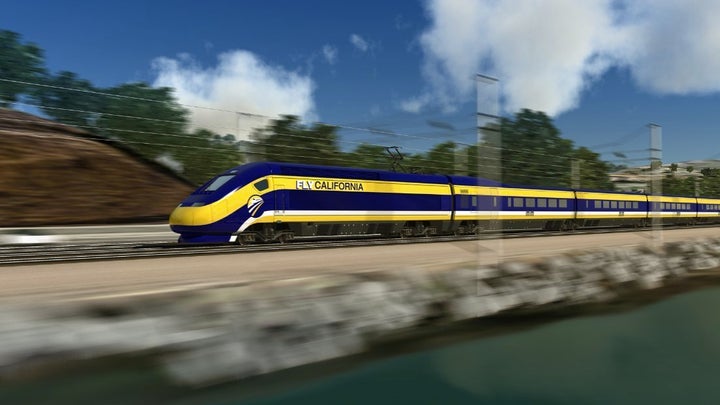
Long-term planning, visionary thinking, and the courage and wisdom to act upon what is in the best interests of society, regardless of the short-term consequences, political or otherwise, are the hallmarks of a progressive society. Our state and our nation have been built upon the bedrock of healthy competition and prudent risk-taking. It is what has made us an economic powerhouse. And given the demands facing this nation over the next several decades it is incumbent upon us to prepare for the challenges of an increasingly flat and interconnected world. Transportation will play a major role in connecting us to the future, and we must prepare to do so today.
Given the current economic and budgetary environment and with the political polarization that has gripped our society we increasingly find ourselves stuck in neutral, incapable of moving forward, paralyzed in the face of large problems requiring big solutions. And as we sit idly by our global competitors continue to march boldly into the 21st century. Some say we cannot afford to compete, but in actuality we simply cannot afford not to compete.
A prominent issue facing California and Californians at this moment is a decision on whether to build a high-speed rail transportation network connecting North and South and all points in between. Recently, the California High-Speed Rail Authority issued its 2012 draft Business Plan (The Plan) outlining a solid financial blueprint for moving forward on construction of America's first "bullet train." The Plan is grounded in fairly conservative economic assumptions and a realistic portrayal of the current funding environment in Washington, D.C. It reflects an economic roadmap that is as bold as it is competitive, and it is needed now more than ever.
The Plan is sober and realistic in its approach. For instance, with respect to Federal funding, which will be required to build the project, The Plan assumes 61 percent Federal investment, rather than the traditional 80-90 percent Federal match in traditional major transportation and infrastructure projects.
Also, The Plan does not assume additional Federal funding, on top of the $3.3 billion already identified, for the next three years. By building the project in discreet, distinct segments, no construction will commence unless funding is identified. Once the project is operational, within 10 years hopefully, private capital will contribute to the project. The citizens of California have voted on nearly $10 billion in bonds for the project. Truly, the project will incorporate the quintessential assets of a public/private partnership and represents a coordinated and comprehensive public/private investment in our future.
As with any large infrastructure project, the costs over the next two decades are large, think of the Interstate Highway System, or the State university system. However, it is wrong and misguided to isolate the $98 billion cost of this system in a vacuum. On a straight-line cost-benefit analysis the benefits far outweigh the costs. For example, in order to accommodate the large population increases in the state over the next 40 years (38-60 million) the costs of meeting infrastructure needs through building 2,300 additional lanes of freeways and 4 additional runways, and 115 additional airline gates would run to a staggering $171 billion. And it is not feasible to realistically consider expanding airports in major cities like San Francisco or Los Angeles. Building more freeways invites more congestion and more automobiles, worsening time delays and the environment.
This "business as usual" approach would exacerbate already intolerable traffic congestion and airline delays, would continue to add an additional 3 million tons of carbon dioxide into the atmosphere annually and increase hours lost on sitting in traffic by 146 million hours annually. The diminution of our quality of life would be an unacceptable consequence of short-term thinking. And as noted above, the costs of such an approach would be considerably greater than building high-speed rail.
From strictly a cost perspective, we would be paying more and getting less, and one does not need to have an economics degree to realize that this is an unwise investment. And the term investment is the key here. There are good reasons why 24 countries around the world are in the process of building high-speed rail. And while some countries, like Japan, have been operating bullet trains for nearly half a century without a single fatality, we have the ability to learn from those successes and incorporate the latest technology and business practices into the California system.
In a recent article (High Speed Rail: Too Much, Too Late, Nov. 9, 2011) the writer on several occasions questioned whether or not we could afford high-speed rail, referring to it as "an expensive upgrade." In response, I would argue that what we are not talking about here is an expensive upgrade, but rather a wise infrastructure investment that will generate operating revenues and a foundation for the future economic well-being of the generations that will follow us. It is penny wise and pound foolish to rely on an antiquated infrastructure designed for the mid-twentieth century simply because we buy into the misguided notion that we cannot afford to compete. We simply cannot afford not to compete.
The author freely admits that now is not the time to think big and that immediate need such as education and health care dictate that we rein in our vision. But once again this does a disservice to the goal of all that we should leave the world in at least as good a shape as we found it. We simply cannot allow ourselves to be cowed into submission by accepting that we cannot face more than one problem at a time. Under that scenario we will address neither. Besides, the simple economic fact is that time is money, and the longer we wait to build the system, the more it will cost. Inflationary factors, the escalating costs of composite materials such as concrete, copper, and steel, (largely driven by increased demand from places like China, which is in the process of building 9,000 miles of high-speed rail) and realignment due to development all weigh in on the cost of delay.
Henry Ford once said that "If I had asked the customer what they wanted, they would have said a faster horse." In light of our precarious economic state of affairs thinking small merely perpetuates mediocrity. And lest we not forget, there are immediate short-term benefits to construction of high-speed rail, including over 100,000 jobs in the next five years alone. It is estimated that over the life of the project, in excess of one million jobs will be created.
California stands poised to lead the nation into the economic realities of the current century and provide future generations with a transportation network that will both enhance their quality of life and give them a competitive edge on the global economic scene. High-speed rail will contribute to our growth, not stunt it. Every system around the world has experienced net operating revenues once constructed. Ridding our highways of congestion, reducing greenhouse gases into the atmosphere, and increasing the economic productivity of workers by relieving stress and time lost in traffic, relying on power produced by 100 percent renewable energy, and spawning transit oriented development around rail hubs, creating both short-term and permanent jobs, and generally fueling a movement to get us out of our automobiles all are positive benefits for the present and the future.
Yes, there are multiple problems that require our attention, and big thinking, visionary leadership, and the courage to implement a long-term agenda are what are needed. Actually, the time could not be riper for high-speed rail.
